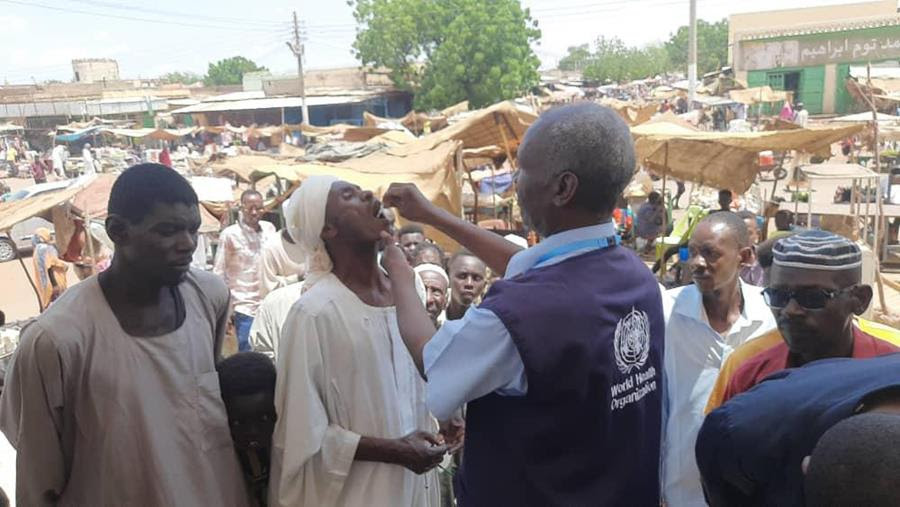Cholera cases in Khartoum State are declining following a 10-day vaccination campaign that reached more than 2.24 million people.
The exercise managed to achieve 96 percent coverage in 12 hot spots in 5 at-risk localities.
Together with response measures such as case management, surveillance, risk communication and community engagement, and improvements in access to safe water, sanitation and hygiene, the campaign contributed to a sustained fall in the number of new cases.
Before the campaign began, Khartoum State was registering up to 1,500 new cases a day.
In the weeks following the campaign new cases continued to fall.
There were just between 10 and 11 new cases a day being registered by 11 July 2025.
A nationwide cholera outbreak
Though case numbers in Khartoum State have declined, the outbreak has spread to all but one –Central Darfur State – of Sudan’s 18 states.
The spread to North, South, West and East Darfur states and to North, South and West Kordofan states is particularly concerning given limited access and the already dire humanitarian and health crises in these states.
“The World Health Organization (WHO) is coordinating the response with Sudan’s health authorities and our teams are on the ground providing technical assistance and capacity-building.”
“We are also dispatching cholera and other essential medical supplies to affected localities,” said WHO Representative in Sudan Dr Shible Sahbani.
Darfur and Kordofan
“We are exploring all possible ways to deploy medical supplies and technical support to the hard-to-reach Darfur and Kordofan states, including cross-border operations through Chad and South Sudan.”
By 11 July 2025, almost a year after the current wave of cholera outbreak started in late July 2024, the disease had infected 87,219 people and caused 2,260 deaths – a case fatality ratio of 2.6 percent.
The outbreak is fuelled by displacement, lack of access to safe water, sanitation and hygiene caused by the breakdown of water supply systems, and limited amounts of medical supplies for the management of cases.
There have been two surges in cases since 2025, one in March and the second in May, likely linked to drone attacks on power and water system infrastructure which severely compromised access to safe water and adequate health care.
Expanding oral cholera vaccination coverage to curb the outbreak
The World Health Organization, with the United Nations Children’s Fund (UNICEF), continues to support campaigns in other affected states, including a 10-day vaccination campaign in North Kordofan State in June, reaching more than 265,518 people and, since 10 July, an ongoing campaign in Sennar targeting more than 500,000 people.
An additional 3 million doses of vaccines have arrived in the country to cover 3 additional localities in Khartoum, and 500,000 doses are pending clearance to be deployed to South Darfur.

In light of the evolving epidemiological situation and the resurgence of cases in multiple conflict-affected regions, the International Coordinating Group on Vaccine Provision (ICG) Secretariat has approved the shipment of an additional 2.9 million doses of Oral Cholera Vaccines (OCV) for reactive campaigns in 11 high-risk localities in 7 affected states.
The affected states include, Al Jazirah, East Darfur, South Darfur, North Kordofan, West Kordofan, White Nile and Sennar.
The International Coordinating Group on Vaccine Provision (ICG) has four member agencies: WHO, UNICEF, the International Federation of Red Cross and Red Crescent Societies (IFRC) and Médecins Sans Frontières (MSF).
The World Health Organization’s response to the cholera outbreak in Sudan, including vaccination campaigns, is possible through the financial support of Gavi, the Vaccine Alliance, the United Nations Central Emergency Response Fund (CERF), the French Ministry for Europe and Foreign Affairs, Directorate-General for European Civil Protection and Humanitarian Aid Operations (ECHO) and the WHO Contingency Fund for Emergencies (CFE).

